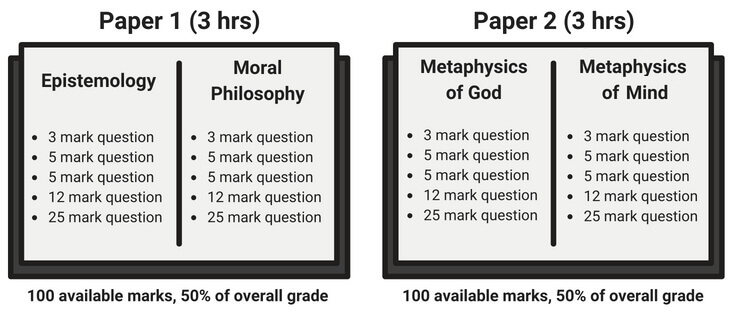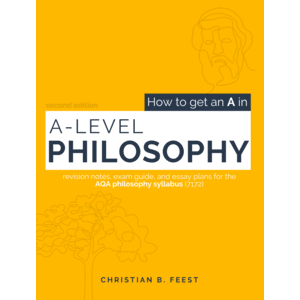
The AQA philosophy A level (7172) assessment is sat at the end of the course and consists of two 3 hour examinations:
- Paper 1 will have 5 questions on epistemology and 5 questions on moral philosophy
- Paper 2 will have 5 questions on the metaphysics of God and 5 questions on metaphysics of mind
Each paper is worth 50% of the overall grade.
There are 10 questions per paper (5 for each module) in the following format:
- 3 mark question
- 5 mark question
- 5 mark question
- 12 mark question
- 25 mark question
- 3 mark question
- 5 mark question
- 5 mark question
- 12 mark question
- 25 mark question
This makes a total of 20 questions across both papers and 200 total available marks. This can be broken down into 100 marks per paper or 50 marks per module.
Assessment Criteria
The questions in the papers are assessed according to two key criteria:
- AO1: Knowledge and understanding of key philosophical texts and ideas.
- AO2: The ability to critically evaluate these ideas and argue toward a conclusion.
Each paper asks a series of questions that test these skills to differing degrees.
AO1
The majority of marks are awarded for AO1.
AO1 tests your knowledge and understanding of key ideas and philosophers. You do not need to argue for or against a view, or give your opinion.
All questions except 25 mark questions are 100% AO1. This is simple enough when it’s a small question – e.g. 3 marks – you might just need to give a short definition of the key points.
Longer questions – such as 5 marks and 12 marks – are a little more difficult, but still 100% AO1. The topic you’re asked about is likely to be more complicated, requiring you to go into more detail to demonstrate your understanding and pick up the AO1 marks.
Even so, you are not required to evaluate the arguments or give your view. You only need to explain. No marks are awarded for argument.
AO2
25 mark questions award 20 marks for AO2 – evaluation and argument.
So, instead of just explaining a philosophical view, you have to argue whether it is or isn’t the correct one.

The format of a good A level philosophy argument might look like this:
- Introduction
- Define key points
- Explain which side you are arguing for
- Argument for X
- Possible response to this argument
- Response to this response
- Possible response to this argument
- Argument against X
- Response to this argument
- Conclusion: X is correct because of the arguments above
The key phrase in the syllabus for AO2 is ‘arguing with intent’. This means that you argue consistently for or against a viewpoint (e.g. act utilitarianism is wrong). You provide the arguments in favour of your view, and also respond to any possible objections to your view.
A good argument goes into detail. It is better to give one or two strong and detailed arguments for your view than to simply list everything you’ve learned on the topic without any substance (if in doubt; think point, evidence, explanation). Quality is better than quantity.
When you come to write your conclusion, make sure it is consistent with what you’ve written previously (and what you said you’d argue in your introduction). Finally, don’t introduce new ideas here – your conclusion should only be a summary of what you’ve previously argued.
For more detail on structuring 25 mark essays, see this post. And for examples of A* grade 25 mark answers, check out the example essays page.
Grade Boundaries
Below are rough ballpark minimum percentages needed for each letter grade boundary:
- A* ~70%
- A ~60%
- B ~50%
- C ~40%
- D ~25%
- E ~15%
Grade boundaries differ from year to year. If it’s an ‘easy’ paper and everyone gets a high mark, for example, then the grade boundaries for each letter grade will be slightly higher.
2024 Exam Dates
- Paper 1/Epistemology and Moral Philosophy: 16th May 2024 (afternoon)
- Paper 2/Metaphysics of God and Metaphysics of Mind: 22nd May 2024 (afternoon)